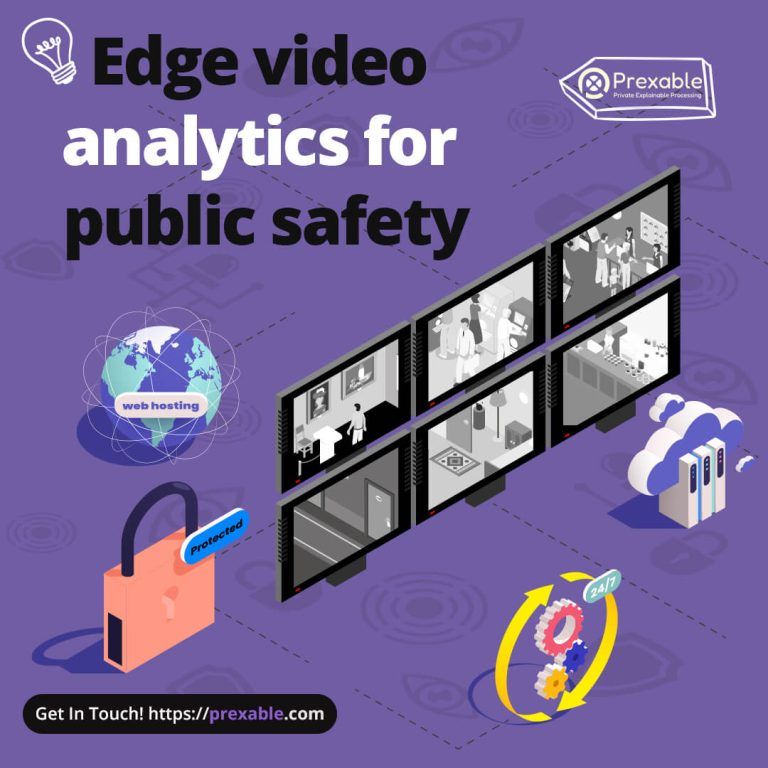Leveraging Edge Video Analytics for Enhanced Public Safety

Introduction
In the era of advanced technology, video analytics has evolved to become a vital tool for ensuring public safety. By integrating Computer Vision (CV) and Artificial Intelligence (AI), video analytics aims to address the “four W” problem: Who did What, Where, and When. These capabilities have diverse applications, ranging from post-event analysis for archiving and forensic investigations to real-time video stream analysis for situation awareness and object detection. However, this evolution has brought new challenges and demands, particularly with the need for sophisticated image processing algorithms.
This blog post delves into the realm of edge video analytics for public safety, an emerging field that promises to revolutionize the way we approach security and surveillance. The idea behind edge video analytics is to perform video analysis tasks as close to the source as possible, which in this case means the cameras themselves or nearby edge servers. This approach offers several advantages, including lower data transmission overhead, reduced response latency, and the ability to enable innovative applications.
What is the Edge Video Analytics
Edge video analytics, also known as edge AI video analytics or edge computing video analytics, is a technology that involves processing and analyzing video data locally on edge devices, such as cameras or IoT (Internet of Things) devices, rather than transmitting the data to a centralized server or cloud for analysis. This approach brings real-time data processing and decision-making capabilities closer to the data source, which offers several advantages:
Low Latency: By processing video data at the edge, near the source of the data, latency is significantly reduced. This is crucial for applications where real-time or near-real-time analysis is required, such as security monitoring, autonomous vehicles, and industrial automation.
Bandwidth Efficiency: Edge video analytics can reduce the amount of data that needs to be transmitted to the cloud or a central server. This is particularly important in scenarios with limited network bandwidth or in applications where sending all video data to the cloud is cost-prohibitive.
Privacy and Security: Processing video data locally can enhance privacy and security because sensitive information doesn’t need to leave the edge device. This is important for applications like home security and surveillance, where privacy concerns are significant.
Redundancy and Robustness: In scenarios with unreliable or intermittent network connectivity, edge analytics ensures that data analysis can continue even when the connection to the cloud is lost.
Cost Efficiency: Edge video analytics can reduce the costs associated with sending large volumes of video data to the cloud and maintaining expensive cloud infrastructure.
Edge video analytics typically involves the use of specialized hardware and software designed to run machine learning and computer vision algorithms on edge devices. These algorithms can perform tasks such as object detection, facial recognition, anomaly detection, and more, directly on the edge device.
Applications in Public Safety
Public safety has been a driving force behind the growth of video surveillance and analytics. With a myriad of applications, it plays a crucial role in crime prevention and incident monitoring. Traditionally, video data was sent to centralized cloud systems for analysis, but as the scale of surveillance systems has increased, this approach has become inefficient. Edge video analytics steps in to address this challenge by allowing part or all of the video analysis to be done on the edge devices, such as cameras and edge servers.
One of the most notable advantages of Edge Video Analytics for Public Safety (EVAPS) is its ability to minimize data transmission overhead. This is particularly valuable for mobile cameras used by the police, Unmanned Aerial Vehicles (UAVs), and firefighting robots. In situations where network connections are unstable, EVAPS ensures that video analysis can be performed without significant latency. For example, body-worn cameras used by law enforcement officers can automatically capture and report incidents, enhancing both public safety and officer security.
Challenges and Opportunities
While edge video analytics presents a promising solution to the challenges of traditional cloud-based systems, it also poses its own set of challenges. The optimal distribution of workloads in an edge-cloud environment, especially in real-time video analysis, remains a complex problem for both industry and academia.
Public Safety Applications: We explore how edge video analytics is being applied in various departments, including the police, transportation, fire, and EMS. Notably, crime identification has seen significant success in city-wide surveillance systems.
Video Analytics Algorithms: We delve into the video analytics process and examine typical algorithms used for specialized applications in public safety, such as face recognition, vehicle recognition, and flame detection.
Edge Video Analytics Platforms: We review existing platforms and systems that partially support workload offloading, providing reference points for the development of future EVAPS frameworks.
In conclusion, edge video analytics is a game-changer in the realm of public safety. By harnessing the power of edge computing, we can achieve lower latency, reduced data transmission, and enhanced real-time analysis, ultimately leading to safer communities. Stay tuned for more insights into the exciting world of edge video analytics and its role in shaping the future of public safety.